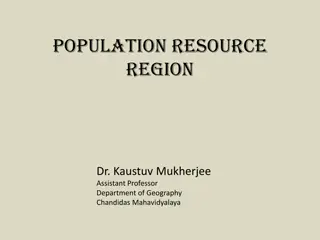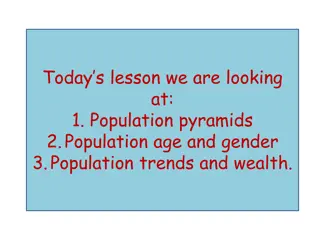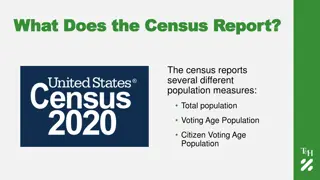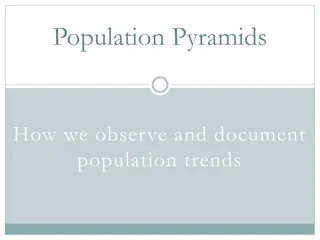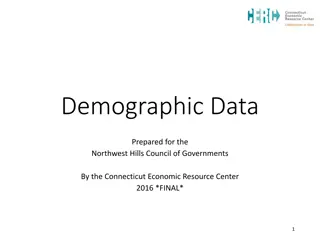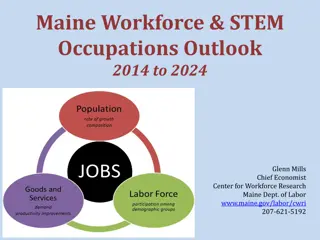Population and Jobs Trends Over Time
This data visualizes the historical population growth and job trends from 1970 to 2050. It demonstrates how population and job numbers have evolved over the years, providing insights into the changing workforce dynamics and societal patterns. Analyzing this information can help in understanding the correlation between population growth and employment opportunities.
Download Presentation

Please find below an Image/Link to download the presentation.
The content on the website is provided AS IS for your information and personal use only. It may not be sold, licensed, or shared on other websites without obtaining consent from the author.If you encounter any issues during the download, it is possible that the publisher has removed the file from their server.
You are allowed to download the files provided on this website for personal or commercial use, subject to the condition that they are used lawfully. All files are the property of their respective owners.
The content on the website is provided AS IS for your information and personal use only. It may not be sold, licensed, or shared on other websites without obtaining consent from the author.
E N D
Presentation Transcript
Population and Jobs 4,500,000 4,000,000 3,500,000 3,000,000 2,500,000 2,000,000 1,500,000 1,000,000 500,000 0 1970 1972 1974 1976 1978 1980 1982 1984 1986 1988 1990 1992 1994 1996 1998 2000 2002 2004 2006 2008 2010 2012 2014 2016 2018 2020 2022 2024 2026 2028 2030 2032 2034 2036 2038 2040 2042 2044 2046 2048 2050 Population (Historical) Population (SR13) Jobs (Historical) Jobs (SR13)
Taxable Retail Sales Per Capita $26,000 $24,000 $22,000 $20,000 2010 Constant $ $18,000 $16,000 $14,000 $12,000 $10,000 1970 1972 1974 1976 1978 1980 1982 1984 1986 1988 1990 1992 1994 1996 1998 2000 2002 2004 2006 2008 2010 2012 2014 2016 2018 2020 2022 2024 2026 2028 2030 2032 2034 2036 2038 2040 2042 2044 2046 2048 2050 Historical SR13
Total Income Per Capita $90,000 $85,000 $80,000 $75,000 $70,000 $65,000 2010 Constant $ $60,000 $55,000 $50,000 $45,000 $40,000 $35,000 $30,000 $25,000 $20,000 1970 1972 1974 1976 1978 1980 1982 1984 1986 1988 1990 1992 1994 1996 1998 2000 2002 2004 2006 2008 2010 2012 2014 2016 2018 2020 2022 2024 2026 2028 2030 2032 2034 2036 2038 2040 2042 2044 2046 2048 2050 Historical SR13
Total Income Per Capita and Average Annual Wage $90,000 $85,000 $80,000 $75,000 $70,000 $65,000 2010 Constant $ $60,000 $55,000 $50,000 $45,000 $40,000 $35,000 $30,000 $25,000 $20,000 1970 1972 1974 1976 1978 1980 1982 1984 1986 1988 1990 1992 1994 1996 1998 2000 2002 2004 2006 2008 2010 2012 2014 2016 2018 2020 2022 2024 2026 2028 2030 2032 2034 2036 2038 2040 2042 2044 2046 2048 2050 Historical SR13 Average Wage (Historical) Average Wage (SR13)
Total Income $160,000 $150,000 $140,000 $130,000 $120,000 $110,000 $100,000 Mln 2010 Constant $ $90,000 $80,000 $70,000 $60,000 $50,000 $40,000 $30,000 $20,000 $10,000 $0 1965 1970 1975 1980 1985 1990 1995 2000 2005 2010 2015 2020 BEA Decennial Census/ACS IRS
Total Income Per Capita $55,000 $50,000 $45,000 $40,000 $35,000 2010 Constant $ $30,000 $25,000 $20,000 $15,000 $10,000 $5,000 $0 1965 1970 1975 1980 1985 1990 1995 2000 2005 2010 2015 2020 BEA Decennial Census/ACS IRS
BEA Personal Income Includes Money and Not Money Income Some of the items in the BEA s Not Money Income Interest on private pension plans IRA and Keogh dividends Small business corporation income Rental value of owner-occupied housing Capital consumption adjustment Employer contributions to private pension and profit-sharing funds
Taxable Retail Sales Per Capita $30,000 $28,000 $26,000 $24,000 $22,000 2010 Constant $ $20,000 $18,000 $16,000 $14,000 $12,000 $10,000 1970 1972 1974 1976 1978 1980 1982 1984 1986 1988 1990 1992 1994 1996 1998 2000 2002 2004 2006 2008 2010 2012 2014 2016 2018 2020 2022 2024 2026 2028 2030 2032 2034 2036 2038 2040 2042 2044 2046 2048 2050 Historical SR10 SR11 SR12 SR13 Linear (Historical)
Taxable Retail Sales $110,000 $100,000 $90,000 $80,000 $70,000 Mln 2010 Constant $ $60,000 $50,000 $40,000 $30,000 $20,000 $10,000 $0 1970 1980 1990 2000 2010 2020 2030 2040 2050 Historical SR13 $18k per person $16k per person $14k per person
Issues with DEFM Everything is connected in DEFM, which makes it overly deterministic and inflexible Inable to handle multiple equilibria (different states); e.g., different outputs from the same inputs The salient feature of DEFM is its dependence on an external forecast for the US economy Demographic module aside, DEFM is just an elaborately repackaged Moody s (Global Insight s) forecast Our proposal Switch to a different TYPE of model
From Forecasts to Scenarios Not just rebuild DEFM, but pivot to a different modeling approach Scenarios instead of predictions In DEFM, key indicators of the future are supplied by an external forecast for the US (we ve used Moody s and Global Insight) We want to treat these indicators as clearly stated IF assumptions Migration rates Labor force participation rates Unemployment rates (overall and cohort-specific) Average wage Average non-wage income (cohort-specific) The forecast then becomes a plausible what if scenario The goal is to generate an internaly consistent and reasonable future for a regional system
Projected TransNet Revenues (Mln 2010 $) $14k Scenario 1,406 2,528 2,701 2,239 8,875 $16k Scenario 1,607 2,890 3,087 2,559 10,142 $18k Scenario 1,808 3,251 3,473 2,879 11,410 SANDAG POF 1,512 3,037 3,745 3,476 11,771 SR13 1,612 3,255 4,014 3,726 12,607 2015-2020 2021-2030 2031-2040 2041-2048 2015-2048 Surplass (Deficit) Relative to SANDAG POF (Mln 2010 $) $14k Scenario $16k Scenario $18k Scenario SANDAG POF SR13 2015-2020 2021-2030 2031-2040 2041-2048 2015-2048 99 218 269 250 836 (106) (509) (1,044) (1,237) (2,896) 95 295 213 (272) (597) (361) 0 0 0 0 0 (148) (658) (917) (1,628)
Population and Taxable Retail Sales 5,000,000 $400,000 4,500,000 $350,000 4,000,000 $300,000 3,500,000 Taxable Retail Sales (mln) $250,000 3,000,000 Population 2,500,000 $200,000 2,000,000 $150,000 1,500,000 $100,000 1,000,000 $50,000 500,000 - $0 1970 1980 1990 2000 2010 2020 2030 2040 2050 Population (Historical) Population (SR13) Taxable Retail Sales (Historical) Taxable Retail Sales (SR13)
Personal Income and Taxable Retail Sales $800,000 $700,000 $600,000 $500,000 Million $400,000 $300,000 $200,000 $100,000 $0 1970 1980 1990 2000 2010 2020 2030 2040 2050 Income (Historical) Income (SR13) Taxable Retail Sales (Historical) Taxable Retail Sales (SR13)
Compound Annual Growth Rates (Historical and SR13) 15.0% 14.0% 13.0% 12.0% 11.0% 10.0% 9.0% 8.0% 7.0% 6.0% 5.0% 4.0% 3.0% 2.0% 1.0% 0.0% 1970-1980 1980-1990 1990-2000 2000-2010 2010-2020 2020-2030 2030-2040 2040-2050 Population Wage & Salary Jobs Total Personal Income (mln current $) Taxable Retail Sales (mln current $)
Total Personal Income $180,000 $160,000 $140,000 $120,000 $100,000 Million $80,000 $60,000 $40,000 $20,000 $0 1969 1979 1989 1999 2009 2013 Decennial Census/ACS IRS BEA
Average Annual Wage (current $) $250,000 $225,000 $200,000 $175,000 $150,000 $125,000 $100,000 $75,000 $50,000 $25,000 $0 1970 1980 1990 2000 2010 2020 2030 2040 2050 BLS BEA SR13 Linear (BEA)
Compound Annual Growth Rate for Average Wage (current $) 8.0% 7.0% 6.0% 5.0% 4.0% 3.0% 2.0% 1.0% 0.0% 1970-1980 1980-1990 1990-2000 2000-2010 2010-2020 2020-2030 2030-2040 2040-2050 BLS BEA SR13
Taxable Retail Sales--Actual less Forecast $7,500 $5,000 $2,500 $0 2000 2001 2002 2003 2004 2005 2006 2007 2008 2009 2010 2011 2012 2013 -$2,500 SR10 SR11 -$5,000 Million SR12 SR13 -$7,500 -$10,000 -$12,500 -$15,000 -$17,500 -$20,000
Taxable Retail Sales $350,000 $325,000 $300,000 $275,000 $250,000 $225,000 $200,000 Million $175,000 $150,000 $125,000 $100,000 $75,000 $50,000 $25,000 $0 1970 1972 1974 1976 1978 1980 1982 1984 1986 1988 1990 1992 1994 1996 1998 2000 2002 2004 2006 2008 2010 2012 2014 2016 2018 2020 2022 2024 2026 2028 2030 2032 2034 2036 2038 2040 2042 2044 2046 2048 2050 Actual SR10 SR11 SR12 SR13 Test Linear (Actual)
Population and Taxable Retail Sales 5,000,000 $400,000 4,500,000 $350,000 4,000,000 $300,000 3,500,000 Taxable Retail Sales (mln) $250,000 3,000,000 Population 2,500,000 $200,000 2,000,000 $150,000 1,500,000 $100,000 1,000,000 $50,000 500,000 - $0 1970 1980 1990 2000 2010 2020 2030 2040 2050 Population (Historical) Population (SR13) Taxable Retail Sales (Historical) Taxable Retail Sales (SR13) Linear (Population (Historical)) Linear (Taxable Retail Sales (Historical))
Taxable Retail Sales (mln $) Transnet (mln $) Test less DEFM (SR13) (118) (782) (1,196) (1,992) Test less SANDAG POF (284) (638) (491) SANDAG POF 392,190 966,342 1,484,946 1,667,546 4,511,024 SANDAG POF 1,839 4,508 6,927 7,779 21,054 DEFM (SR13) 392,190 966,342 1,484,945 1,667,546 4,511,024 Test 413,035 942,704 1,328,565 1,428,310 4,112,614 DEFM (SR13) 1,961 4,832 7,425 8,338 22,555 Test 2,065 4,714 6,643 7,142 20,563 2015-2020 2021-2030 2031-2040 2041-2048 2015-2048 104 226 206
Issues with DEFM TRS growing faster than income Income growth rates are high Uses BEA Total Personal Income Includes non-money income While total income is misleading, it doesn t by itself lead to biased TRS estimates As long as the share of non-money income stays the same Higher base levels of wage & salary income Extremely cheerful average wage growth rates
Long-Range Forecasting Future is not like a content of an unopened envelop, which can be somehow revelead; the future hasn t been written yet Forecasting (predicting the inevitable) is all about extending trajectories However, trajectories have relatively short lives; that s why forecasting is suited for short-term Unemployment rate forecast for next quarter is meaningful But long-term is different Trajectories (and forces behind them) will change many times Forecast for unemployment rate in 2050 is meaningless because it is unknowable So we have to make an assertion and use it as an assumption
Changes to the Macro Model Migration Cohort-specific gross migration (in/out), domestic and international Employment-Population Coupling Cohort-specific labor-force participation and unemployment rates Income Industry-specific average wages Cohort-specific self-employment income and unearned income (persions, social security, rental income, supplemental income) Housing Supply Belongs in the LU model
Components of Demographic Change 70,000 60,000 50,000 40,000 30,000 20,000 10,000 0 1971 1972 1973 1974 1975 1976 1977 1978 1979 1980 1981 1982 1983 1984 1985 1986 1987 1988 1989 1990 1991 1992 1993 1994 1995 1996 1997 1998 1999 2000 2001 2002 2003 2004 2005 2006 2007 2008 2009 2010 2011 2012 2013 2014 -10,000 -20,000 -30,000 -40,000 -50,000 Births Deaths Net Migration Net Domestic Migration Net Foreign Migration
Domestic Migration Estimates for San Diego County (IRS data) 140,000 130,000 120,000 110,000 100,000 90,000 80,000 70,000 Households, Persons 60,000 50,000 40,000 30,000 20,000 10,000 0 1996 1997 1998 1999 2000 2001 2002 2003 2004 2005 2006 2007 2008 2009 2010 2011 2012 2013 -10,000 -20,000 -30,000 -40,000 In Households Out Households Net Households In Persons Out Persons Net Persons
Migration to/from San Diego County 180,000 5% 160,000 140,000 4% 120,000 100,000 80,000 60,000 1% 40,000 20,000 0 2005-2009 2006-2010 2007-2011 2008-2012 2009-2013 -20,000 -40,000 From California To California Domestic In Domestic Out From Abroad Net Domestic
Migration to/from San Diego County 32,500 30,000 27,500 25,000 22,500 20,000 17,500 15,000 12,500 10,000 7,500 5,000 2,500 0 01 to 04 years 05 to 17 years 18 to 19 years 20 to 24 years 25 to 29 years 30 to 34 years 35 to 39 years 40 to 44 years 45 to 49 years 50 to 54 years 55 to 59 years 60 to 64 years 65 to 69 years 70 to 75 years 75 years and over -2,500 -5,000 Domestic In Domestic Out From Abroad Net Domestic
Total Population 4.5 Millions 4.4 4.3 4.2 4.1 4.0 3.9 3.8 3.7 3.6 sr14 ? 3.5 sr13 3.4 sr12 3.3 sr11 3.2 3.1 sr10 3.0 2.9 2.8 2.7 2.6 2.5 2000 2002 2004 2006 2008 2010 2012 2014 2016 2018 2020 2022 2024 2026 2028 2030 2032 2034 2036 2038 2040 2042 2044 2046 2048 2050
Integrated Models SANDAG s suite of models and tools Evolved organically DEFM,Concep,Pacef,ABM,PopSyn,PECAS,UrbanSim Overlaps, inconsistencies, conflicts From a jerry-rigged solution to First, an integrated modeling platform Streamlined, logical data flow Then, a fully disaggregated behavioral system Real Estate Markets (Parcels in UrbanSim) Daily Activity Schedules (Individuals in ABM) Socioeconomic Evolution (Households in the Demographic model)
Idea #1: Annual Release Update (release) frequency should match the temporal resolution of a forecast Daily forecast is updated daily Annual forecast is updated annualy Incorporation of most recent data Demographic and Employment Land use (actual and planned development, zoning changes) Linking to the annual estimates Production schedule with firm dates
Idea #2: Interval instead of Point Components of demographic change Births, deaths, migration Cumulative impact The illusion of determinism SD County (2013): 43,627 births and 20,602 deaths Were the exact numbers somehow preordained??? Inherent uncertainty in demographic forecasts Even if we get all the trends right Solution High/Low Bounds Update (correct) often
Idea #3: Model Integrity We need to maintain the integrity of the model by enforcing a clear distinction between model inputs and outputs Inputs current conditions (facts) operating rules (model s logic) policy instruments (transporation, zoning) Outputs what comes out of the model (forecast) if the output is wrong , we need to know why (so that we can make appropriate corrections) Ok to change inputs (correct factual errors, deficient rules, test different policies), but not outputs
Idea #4: LUT Scenarios Components of the land use system A. Regional transportation policy Transportation investment scenarios Directly affects accessability land rent B. Local LU regulatory policy (zoning, fees) Zoning scenarios Prescribes (but does not esure!) development form C. Private development enterprize What developers actually build PECAS/UrbanSim: predict what/when/where developes will build in the future C responds to A, is constrained by B A and B are given, C is to be determined (i.e., forecasted)
Idea #4: LUT Scenarios (cont.) A land use forecast is our best guess about the consequence of certain policy decisions, it should be informed by, and be consistent with, policy decisions At minimum, each transportation investment scenario should beget its own land use scenario (and perhaps a demographic one too) Ideally, zoning scenarios should be used as well (to leverage transporation investments) Implications for the RTP Create transportation scenarios first, then generate a forecast
Outline Rethinking the Macro model (DEFM) Developing an integrated suite of models New ideas for forecasting and modeling
Ethnic Composition of Migrants and Residents in San Diego 70% 60% 50% 40% 30% 20% 10% 0% Hispanic White, not Hispanic Asian Black Other Current Population Domestic In Domestic Out Foreign In
Migration to/from San Diego County (by Country of Birth) 8,000 7,000 6,000 5,000 4,000 3,000 2,000 1,000 0 Europe China India Philippines Rest of Asia Mexico Central America Rest of the World -1,000 -2,000 -3,000 Domestic In Domestic Out From Abroad Net Domestic
Migration to/from San Diego County (by Household Income) 25,000 20,000 15,000 10,000 5,000 0 1 Less than $10,000 2 $10,000 to $14,999 3 $15,000 to $24,999 4 $25,000 to $34,999 5 $35,000 to $49,999 6 $50,000 to $74,999 7 $75,000 to $99,999 8 $100,000 to $149,999 9 $150,000 or more -5,000 Domestic In Domestic Out From Abroad Net Domestic
Domestic Migration Estimates for San Diego County (IRS data) $70,000 $60,000 $50,000 Average Income $40,000 $30,000 $20,000 $10,000 $0 1996 1997 1998 1999 2000 2001 2002 2003 2004 2005 2006 2007 2008 2009 2010 2011 2012 2013 In Households Out Households
Age Composition of Migrants and Residents in San Diego 25% 20% 15% 10% 5% 0% 01 to 04 years 05 to 17 years 18 to 19 years 20 to 24 years 25 to 29 years 30 to 34 years 35 to 39 years 40 to 44 years 45 to 49 years 50 to 54 years 55 to 59 years 60 to 64 years 65 to 69 years 70 to 75 years 75 years and over Current Population Domestic In Domestic Out Foreign In
Domestic Migration Estimates for San Diego County (IRS data) 140,000 12.0% 130,000 120,000 110,000 10.0% 100,000 90,000 80,000 8.0% 70,000 Unemployment Rate 60,000 Persons 50,000 6.0% 40,000 30,000 20,000 4.0% 10,000 0 1996 1997 1998 1999 2000 2001 2002 2003 2004 2005 2006 2007 2008 2009 2010 2011 2012 2013 -10,000 2.0% -20,000 -30,000 -40,000 0.0% In Persons Out Persons Net Persons Unemployment Rate
Domestic Migration Estimates for San Diego County (IRS data) 140,000 $700,000 130,000 120,000 $600,000 110,000 100,000 90,000 $500,000 80,000 70,000 Median Home Price $400,000 60,000 Persons 50,000 40,000 $300,000 30,000 20,000 $200,000 10,000 0 1996 1997 1998 1999 2000 2001 2002 2003 2004 2005 2006 2007 2008 2009 2010 2011 2012 2013 -10,000 $100,000 -20,000 -30,000 -40,000 $- In Persons Out Persons Net Persons Median Home Price
Changes to the Macro Model Migration Cohort-specific gross migration (in/out), domestic and international Employment-Population Coupling Cohort-specific labor-force participation and unemployment rates Income (in addition to wage&salary income) Proprietors (self-employment) income Unearned income (persions, social security, rental income, supplemental income) Housing Supply Belongs in the LU model





